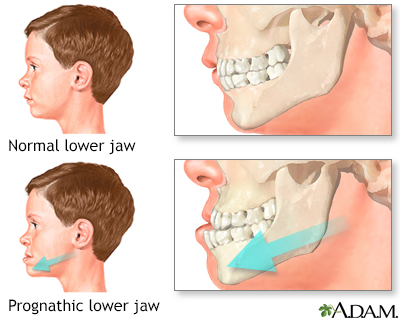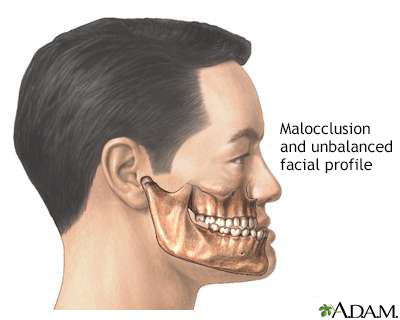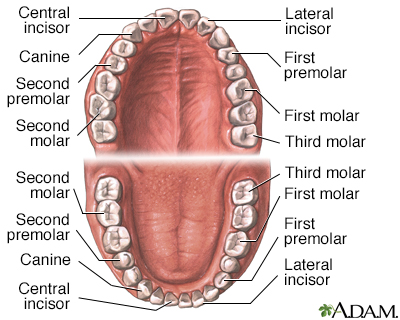Pregnancy SmartSiteTM
Crowded teeth; Misaligned teeth; Crossbite; Overbite; Underbite; Open bite DefinitionMalocclusion means the teeth are not aligned properly. CausesOcclusion refers to the alignment of teeth and the way that the upper and lower teeth fit together (bite). The upper teeth should fit slightly over the lower teeth. The points of the molars should fit the grooves of the opposite molar. The upper teeth keep you from biting your cheeks and lips, and your lower teeth protect your tongue. Malocclusion is most often hereditary. This means it is passed down through families. It may be caused by a difference between the size of the upper and lower jaws or between the jaw and tooth size. It causes tooth overcrowding or abnormal bite patterns. The shape of the jaws or birth defects such as cleft lip and palate may also be reasons for malocclusion. Other causes include:
There are different categories of malocclusion:
SymptomsSymptoms of malocclusion are:
Exams and TestsMost problems with teeth alignment are discovered by a dentist during a routine exam. Your dentist may pull your cheek outward and ask you to bite down to check how well your back teeth come together. If there is any problem, your dentist may refer you to an orthodontist for diagnosis and treatment. You may need to have dental x-rays, head or skull x-rays, or facial x-rays. Diagnostic models of the teeth are often needed to diagnose the problem. TreatmentVery few people have perfect teeth alignment. However, most problems are minor and do not require treatment. Malocclusion is the most common reason for referral to an orthodontist. The goal of treatment is to correct the positioning of the teeth. Correcting moderate or severe malocclusion can:
Treatments may include:
It is important to brush and floss your teeth every day and have regular visits to a general dentist. Plaque builds up on braces and may permanently mark teeth or cause tooth decay if it is not properly removed. You will need a retainer to stabilize your teeth after having braces. Outlook (Prognosis)Problems with teeth alignment are easier, quicker, and less expensive to treat when they are corrected early. Treatment works best in children and adolescents because their bones are still soft and teeth are moved more easily. Treatment may last 6 months to 2 or more years. The time will depend on how much correction is needed. Treatment of orthodontic disorders in adults is often successful, but may require longer use of braces or other devices. Possible ComplicationsComplications of malocclusion include:
When to Contact a Medical ProfessionalCall your dentist if toothache, mouth pain, or other new symptoms develop during orthodontic treatment. PreventionMany types of malocclusion are not preventable. It may be necessary to control habits such as thumb sucking or tongue thrusting (pushing your tongue forward between your upper and lower teeth). Finding and treating the problem early allows for quicker results and more success. ReferencesDean JA, Walsh JS. Managing the developing occlusion. In: Dean JA, ed. McDonald and Avery's Dentistry for the Child and Adolescent. 11th ed. St Louis, MO: Elsevier; 2022:chap 23. Dhar VK. Malocclusion. In: Kliegman RM, St. Geme JW, Blum, et al, eds. Nelson Textbook of Pediatrics. 22nd ed. Philadelphia, PA: Elsevier; 2025:chap 355. Thumbigere-Math V, Hinrichs JE. The role of dental calculus and other local predisposing factors. In: Newman MG, Klokkevold PR, Elangovan S, Hemandez-Kapila YL, eds. Newman and Carranza's Clinical Periodontology and Implantology. 14th ed. Philadelphia, PA: Elsevier; 2023:chap 24. Koroluk LD, Jackson TH. Adolescent patients. In: Stefanac SJ, Nesbit SP, eds. Diagnosis and Treatment Planning in Dentistry. 4th ed. St Louis, MO: Elsevier; 2024:chap 17. Nesbit S, Reside J, Moretti A, et al. The definitive phase of treatment. In: Stefanac SJ, Nesbit SP, eds. Diagnosis and Treatment Planning in Dentistry. 4th ed. St Louis, MO: Elsevier; 2024:chap 11. | ||
| ||
Review Date: 3/31/2024 Reviewed By: Michael Kapner, DDS, General Dentistry, Norwalk Medical Center, Norwalk CT. Review provided by VeriMed Healthcare Network. Also reviewed by David C. Dugdale, MD, Medical Director, Brenda Conaway, Editorial Director, and the A.D.A.M. Editorial team. View References The information provided herein should not be used during any medical emergency or for the diagnosis or treatment of any medical condition. A licensed medical professional should be consulted for diagnosis and treatment of any and all medical conditions. Links to other sites are provided for information only -- they do not constitute endorsements of those other sites. No warranty of any kind, either expressed or implied, is made as to the accuracy, reliability, timeliness, or correctness of any translations made by a third-party service of the information provided herein into any other language. © 1997- A.D.A.M., a business unit of Ebix, Inc. Any duplication or distribution of the information contained herein is strictly prohibited. | ||


 Prognathism
Prognathism Teeth, adult - in ...
Teeth, adult - in ... Malocclusion of te...
Malocclusion of te... Dental anatomy
Dental anatomy
